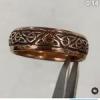I keep getting RFQ's for lasering much bigger area's than my current 150x150 lens will handle easily, so I'm looking looking for a lens that will sweep 8"+. The jobs will involve simple marking of anodized aluminum so power density loss isn't a big deal.
In my usual 'let's see what the cheapest I can find will get me' style, I found and F330/220x220 lens for $99 on ebay. That will get me over 8-1/2" of engraving area which I could really use right now. I've had pretty good luck cheaping out at times-- the Triumph is a good example, and while cheap $18 C02 lenses do scratch easily, they seem to work just fine for what I do.
If the new lens works okay, I'm going to give an 80x80 mm lens a go, I'm curious about the power density for deep metal engraving...
I noticed a 400x400 lens for sale, what I couldn't do with that!




 - fiber lasers
- fiber lasers
 Reply With Quote
Reply With Quote




